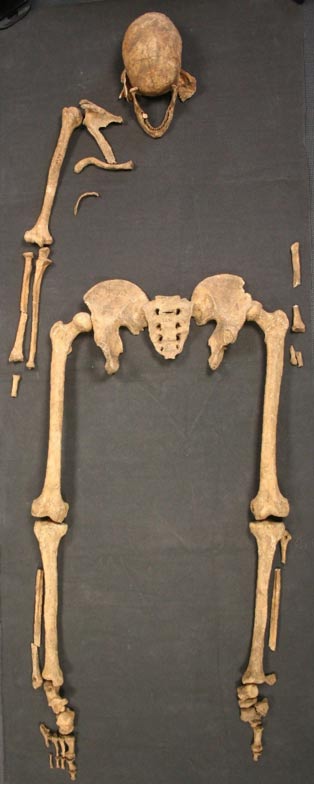
1500-Year-Old Skeleton of Scandinavian Man Might Be Patient Zero in Spread of Leprosy to Britain
The fear and stigma attached to the terrible disease of leprosy has endured for millennia. Answers have long been sought regarding this mysterious ancient ailment, and now archaeologists have diagnosed leprosy in the skeleton of a young Scandinavian man who died in England in the fifth or sixth century. Did leprosy spread to Britain from Scandinavia 1,500 years ago, and was this man the carrier?
As reported by science site Phys.org, an international team of universities have examined the 1,500-year-old Great Chesterford skeleton, so named for the site where the remains were excavated, in an Anglo-Saxon burial in Essex, England.
The bones are those of a man thought to have died in his 20s. Isotopes from his teeth revealed that he probably did not come from Britain, but instead grew up in northern Europe, or southern Scandinavia. His feet had telltale signs consistent with leprosy, such as narrowing of the toe bones and damage to the joints.

Foot bones from the Great Chesterford skeleton. Credit: Inskip et al. 2015
In a news release from the University of Southampton, archaeologist Dr Sonia Zakrzewski said, "Not all cases of leprosy can be identified by changes to the skeleton. Some may leave no trace on the bones; others will affect bones in a similar way to other diseases. In these cases the only way to be sure is to use DNA fingerprinting, or other chemical markers characteristic of the leprosy bacillus."
- Uncovering the ancient roots of leprosy
- New study shows ancient Britons had less gum disease than the modern day
- Unravelling the mystery of disease in ancient Mesopotamia
Tests for bacterial DNA and lipid biomarkers confirmed the man had indeed suffered from leprosy. In fact, the DNA sample was of such good quality that scientists were able to not only confirm leprosy, but also identify which strain; lineage (3I).
The results from tests on his teeth, bones, and DNA corresponded, and suggested a possibility to the archaeologists that he brought a Scandinavian strain of leprosy bacterium to Britain in his travels.
This is the earliest case of leprosy ever confirmed in Britain.

Bones from the feet of a leper, clearly deformed by the illness. Denmark. Representational image. Wikimedia Commons
“The results showed the leprosy strain belonged to a lineage (3I) which has previously been found in burials from Medieval Scandinavia and southern Britain, but in this case it originates from a much earlier period, dating from the 5th or 6th centuries AD,” notes the University of Southampton.

The Great Chesterford skeleton. Credit: University of Southampton
The findings of the study, published in the science journal PLOS One, have the potential to shed light on the ancient origins and movements of leprosy across Britain, and its consequent spread to other parts of the world.
- Unique burial method in Medieval Japan may be linked to social stigma against leprosy
- Medieval Medicine: 1,000-year-old Onion and Garlic Salve Kills Modern Bacterial SuperBugs
- Roseroot, an ancient remedy for fatigue and disease, gets new respect
This chronic infection is caused by a bacteria. Some cases can go 20 years with the patient experiencing few to no symptoms, resulting in a delayed diagnosis. The disease attacks the skin and nerves, and can cause extensive skin lesions, deformities to the face and extremities, and even death.
Largely thought of now as a tropical disease, leprosy’s origins are suspected to date back at least ten million years, based on research conducted at the University of Texas Anderson Cancer Center in 2008. Leprosy still strikes tens of thousands of people worldwide each year but thankfully there are effective antimicrobial drug treatments available today.
An Egyptian Papyrus document dating to 1550 B.C. sites the earliest known account of disease which scholars believe to be leprosy. Later, leprosy first appeared in the records of ancient Greece after Alexander the Great and his troops returned from India and then Rome in 62 B.C.
Leprosy has long been met with fear and ignorance. In antiquity leprosy was thought to be hereditary, the result of a curse, or a divine punishment. In Medieval Europe lepers carried bells to warn of their presence, and were required to keep away from others. Even after the advent of medical science, leprosy patients were still stigmatized, and confined to leper colonies.
Lead study author Sarah Inskip of Leiden University said of the findings of The Great Chesterford skeleton, “This is exciting both for archaeologists and for microbiologists. It helps us understand the spread of disease in the past, and also the evolution of different strains of disease, which might help us fight them in the future.”
Further studies on skeletons from different locations are planned.
Featured Image: A man with leprosy rings a bell to warn of his approach. Wikimedia Commons
By Liz Leafloor














